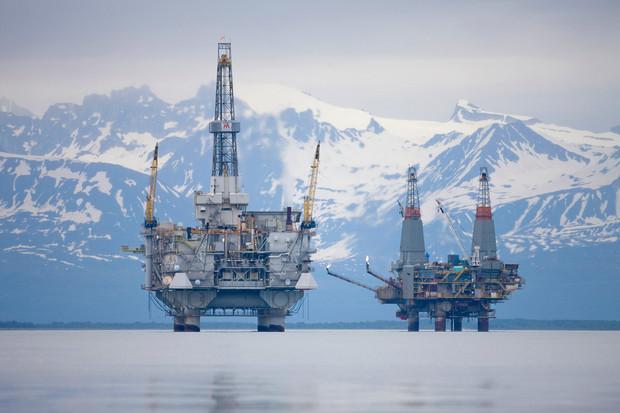
ALASKA: CUT IN HALF

Alaska's oil boom times, which have propped up the state for decades, are coming to an end. In the late 1980s the state produced as much as a quarter of all U.S. crude, about 2 million barrels a day. Over the last 15 years, its daily oil production has been cut in half, to just more than 500,000 barrels. And the fracking boom has unlocked shale oil beneath Texas and North Dakota that is more profitable to extract. Rising oil prices have so far made up for Alaska's declining production, but for a state whose budget relies on oil profits for 90 percent of its revenue, the picture is starting to look troublesome.
Last year, Alaska's Republican-led legislature voted to cut taxes on oil and gas companies, reversing higher tax rates Sarah Palin put in place as governor in 2007. The lawmakers are betting that lower taxes, which budget hawks claim will wind up costing about $2 billion in fiscal 2014, will coax companies to invest in the state and ultimately start producing more oil. An August ballot measure to repeal the tax cuts, which were decried by opponents as a wasteful giveaway to Big Oil, failed by about 5,000 votes. Republican Governor Sean Parnell urged the oil companies to "move those billions of dollars" in tax savings "into work for Alaskans."
They appear to be doing just that. BP (BP) is upping its capital budget in Alaska by 25 percent in 2014, to $1.2 billion. ConocoPhillips (COP), the state's largest producer, is spending $1.7 billion, 50 percent more than in 2013. The company has already raised production in Alaska by 6,000 barrels per day this year and plans to add as many as 40,000 barrels a day by 2018. "The oil companies clearly signaled they'd spend more if their taxes were lowered, and so far that's what they're doing," says David McCaleb, an analyst at energy research firm IHS (IHS). McCaleb expects Alaska's lower taxes will boost total investment from the industry by 10 percent to 15 percent over the next several years.
The question is whether all that investment can reverse Alaska's slide. Oil production in the state was declining decades before Palin's higher taxes went into effect. First discovered in the late 1960s, the state's Prudhoe Bay oil field turned out to be a gusher. From 1976 to 1980, with production growing almost tenfold, from 173,000 barrels a day to 1.6 million, Alaska briefly edged past Texas as the country's top oil-producing state. By the mid-2000s, oil revenue had generated about $50 billion in taxes for Alaska. Some of that money is invested in the state's beloved Permanent Fund, established in 1976, which pays citizens a yearly oil dividend. The fund's balance is currently about $50 billion. Last year everyone got a check for $900.
While that windfall raised the state's standard of living, it also left Alaska dependent on the oil industry, which for years enjoyed low tax rates and little regulation. In 2007, FBI wiretaps caught state officials accepting bribes from oil companies, exposing what many had long suspected: Some of Alaska's most prominent politicians were doing the industry's bidding. Then-Governor Palin cooperated with Democrats to pass a law raising the tax rate on oil and gas profits to 25 percent or higher, depending on oil prices. (This was back when Palin was making her name as a populist reformer, before her transformation into an antitax Tea Partier.)
The timing couldn't have been better. By the summer of 2008, oil prices had jumped almost 50 percent, to $146 a barrel, kicking billions of dollars into the state's coffers. By the time the recession hit and most states were slashing budgets and laying off workers, Alaska was sitting on a $12 billion surplus. "We didn't have a recession in Alaska. We had a slowdown," says Gunnar Knapp, an economist at the University of Alaska at Anchorage.
Yet to avoid the taxes, oil companies eventually cut their operations in the state, hastening the decline in production. By 2011, ConocoPhillips was spending just $774 million in Alaska, half its 2008 investment. The higher taxes also coincided with the shale boom in Texas and North Dakota. All of a sudden, Alaska had to compete with less-remote states awash in oil. "The choice was obvious for a lot of these companies to move money out of Alaska," says Doug Terreson, an oil analyst for ISI Group, a New York-based investment firm.
Short of a large discovery, Alaska is looking at a slow, if profitable, fade-out for its No. 1 industry. Politicians aren't panicking just yet. The Trans-Alaska Pipeline is still flowing, and the Permanent Fund is still flush, meaning there hasn't been much soul-searching about what, if anything, could ultimately take oil's place. "We have not looked in the mirror and said, 'OK, we're gonna be the Silicon Valley of the North,' " says Knapp, the economist. "Even if we don't get back to the glory days, a lot of people think it's still worth it to attract whatever investment we can."
businessweek.com





